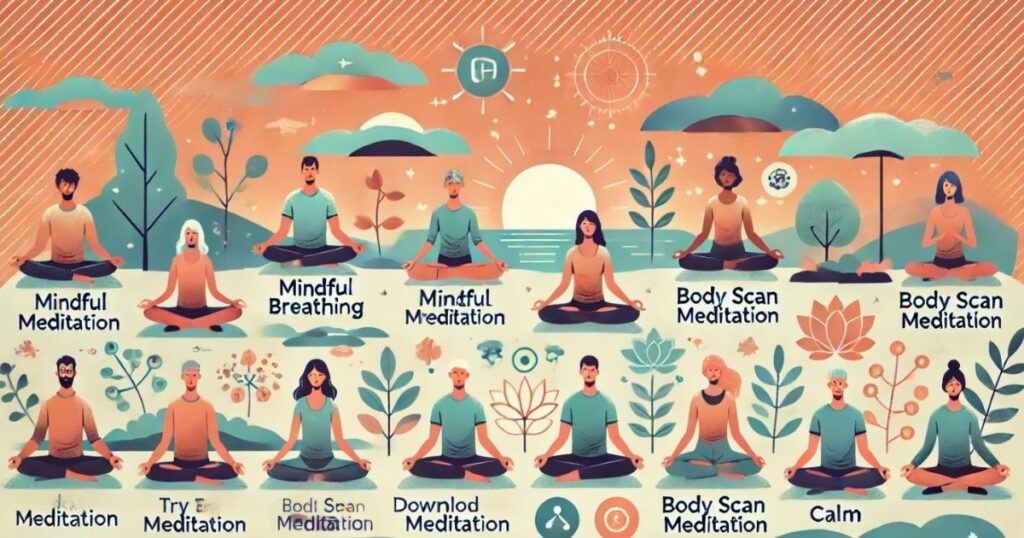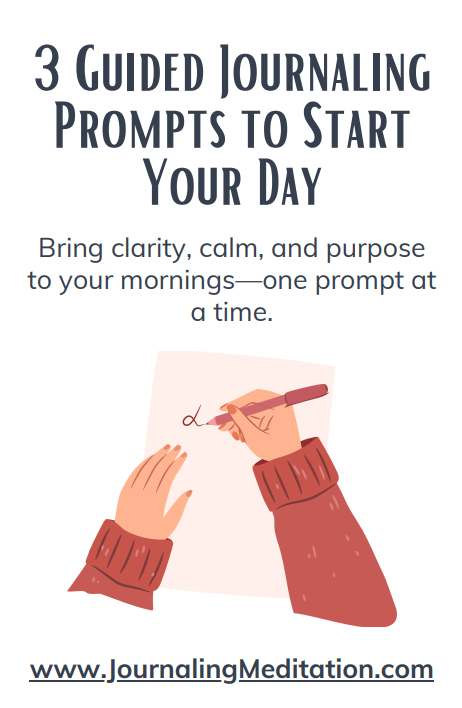
Meditation is a powerful tool for improving mental health, reducing stress, and enhancing overall well-being. For beginners, starting with easy meditation exercises can make the practice simple to begin and more enjoyable. Check out these nine easy meditation exercises for beginners, designed to help you find calm and clarity in your daily life. Whether you’re new to meditation or looking to deepen your practice, these exercises are a great place to start.
(This post contains affiliate links. If you make a purchase through these links, I may earn a commission at no extra cost to you.)
1. Mindful Breathing
What It Is
Mindful breathing is a simple yet effective way to center your mind and body. By focusing solely on your breath, you can cultivate a sense of calm and presence.
How to Do It
Find a quiet, comfortable place to sit. Close your eyes and breathe naturally. Pay attention to the sensation of your breath entering and leaving your nostrils. Notice the rise and fall of your chest and abdomen. If your mind starts to wander, gently bring your focus back to your breath. This exercise can be done for a few minutes or longer, depending on your preference.
2. Body Scan Meditation
What It Is
Body scan meditation brings awareness to different parts of your body, helping you release tension and promotes relaxation.
How to Do It
Lie down or sit comfortably. Close your eyes and start by focusing on your toes. Gradually move your attention up through your body, noticing any areas of tension or stress. Spend a few moments on each body part, simply observing without trying to change anything. This exercise can help you become more aware of your physical state while encouraging a deeper sense of relaxation.
3. Guided Visualization
What It Is
Guided visualization uses mental imagery to help you reach a relaxed and focused state of mind. This exercise can be particularly helpful for beginners who find it challenging to quiet their thoughts.
How to Do It
Find a guided meditation online or use an app. Sit or lie down in a comfortable position and close your eyes. Follow the narrator’s instructions to visualize calming scenes, such as a peaceful beach or a serene forest. Focus on the details of the visualization, engaging all your senses. This can help you create a mental escape and reduce stress.
4. Loving-Kindness Meditation
What It Is
Loving-kindness meditation, also known as Metta meditation, involves cultivating feelings of compassion and love for yourself and others. This practice can enhance emotional strength and nurture a positive outlook.
How to Do It
Sit comfortably and close your eyes. Silently repeat phrases like “May I be happy, may I be healthy.” After a few minutes, extend these wishes to others, including friends, family, and even strangers. Start with people you love, then move to neutral individuals and finally, to those you find challenging. This exercise can help you develop empathy and reduce negative emotions.
5. Walking Meditation
What It Is
Walking meditation combines walking with mindfulness, making it an excellent practice for those who find sitting meditation difficult. Surrounding yourself in nature has relaxing benefits as well.
How to Do It
Find a quiet place where you can walk undisturbed, ideally in a park or nature trail. Walk slowly and focus on the sensation of each step. Notice the lifting, moving, and placing of your feet. Pay attention to the feeling of the ground beneath you and the movement of your body. Listen and notice the sounds and sensations around you. This exercise can be a great way to incorporate mindfulness into your daily routine and take a break from sedentary activities.
6. Mantra Meditation
What It Is
Mantra meditation is simply repeating a word or phrase to focus the mind. This practice can help you develop concentration and inner peace.
How to Do It
Find a quiet, comfortable meditation space to sit or lie down. Choose a calming word or phrase, such as “peace” or “om.” Sit comfortably, close your eyes, and repeat the mantra silently. Sync the mantra with your breath for added focus. If your mind starts to wander, gently return you thoughts to the mantra.
7. Progressive Relaxation
What It Is
Progressive relaxation is the process of tensing and relaxing different muscle groups to promote physical relaxation and reduce stress.
How to Do It
Sit or lie down comfortably. Start with your feet and gradually move up to your head. Tense each muscle group for a few seconds, then release and relax. Pay attention to the feeling of relaxation after releasing the tension. This exercise can help you become more aware of your physical state and release built-up stress.

8. Counting Meditation
What It Is
Counting meditation uses counting to keep your focus on your breath, making it an excellent exercise for beginners who find their mind wandering easily.
How to Do It
Sit comfortably and close your eyes. Inhale and exhale naturally, counting each breath. Count to ten, then start over. If your mind wanders, gently bring it back to the count. It may help to visualize the numbers as you count them. This simple exercise can help you develop concentration and mindfulness.
9. Sound Meditation
What It Is
Sound meditation involves focusing on ambient sounds or specific sound patterns to achieve a meditative state. This practice can be particularly soothing and grounding.
How to Do It
Find a quiet place or use earphones with a sound meditation track. Close your eyes and focus on the sounds you hear. Let the sounds come and go without judging or analyzing them. Natural sounds like ocean waves or bird songs can be particularly soothing and effective in promoting relaxation. Use a singing bowl and try to hear the sound as it diminishes.
————————————————————————————————————————
Taking advantage of these nine easy meditation exercises can significantly improve your mental and emotional well-being. Whether you prefer mindful breathing, body scan meditation, or any of the other practices, there’s something here for everyone. Start with a few minutes each day and gradually increase the duration as you become more comfortable.
I encourage you to try each of these meditation exercises and find your favorite. For more guided practices, consider downloading a meditation app like Headspace or Calm. Remember, meditation is a personal journey, and it’s important to find what works best for you. Happy meditating!

FAQ
Meditation can be a new and sometimes confusing concept for beginners. To help clarify some common questions, I’ve put together a list of frequently asked questions about easy meditation exercises for beginners.
How should a beginner start meditation?
Start by choosing a simple practice, such as mindful breathing or guided visual. It’s important to find a quiet, comfortable place to sit or lie down and start with just a few minutes each day. Consistency is key, so try to meditate at the same time each day to build a habit. Be patient with yourself, as it is the struggle that pays you dividends.
How do you meditate in 5 simple steps?
- Find a Quiet Space: Choose a peaceful, private spot where you won’t be disturbed.
- Get Comfortable: Sit or lie down in a comfortable position.
- Focus on Your Breath: Close your eyes and breathe naturally, paying attention to your breath.
- Observe Your Thoughts: If your mind wanders, just let go of that thought and gently bring your focus back to your breath without judgment.
- Gradually Extend Time: Start with a few minutes and gradually increase the time as you become more familiar with the process.
What are the 3 simple steps to meditation?
- Find a Comfortable Position: Sit or lie down in a position that you can maintain comfortably for the duration of your practice.
- Focus on Your Breath: Close your eyes and pay attention to your breathing, noticing each inhale and exhale.
- Return to the Breath: If your mind wanders, gently bring your focus back to your breath, keeping a non-judgmental awareness.
How to meditate in 10 easy steps?
- Choose a Quiet Place: Find a quiet environment where you won’t be interrupted.
- Sit Comfortably: Sit in a comfortable position with your back straight.
- Close Your Eyes: Gently close your eyes to minimize distractions.
- Take a Few Deep Breaths: Inhale deeply through the nose and exhale slowly through the mouth to relax.
- Focus on Your Breath: Pay attention to the natural rhythm of your breathing.
- Notice Sensations: Observe any sensations in your body without judgment or attention.
- Let Thoughts Pass: Allow thoughts to come and go without clinging to them.
- Return to the Breath: If your mind wanders, bring your focus back to your breath.
- Practice for a Set Time: Start with a few minutes and gradually increase your sessions.
- Gently Open Your Eyes: Slowly open your eyes and take a moment and give thanks before moving on with your day.
What are the mistakes for beginners in meditation?
- Expecting Immediate Results: Meditation benefits can take time to come to the surface. Be patient and consistent with your practice.
- Forcing Concentration: Don’t try to force your mind to be quiet. Instead, notice the thought and gently guide your focus back to your breath.
- Judging Yourself: It’s common for beginners to judge their meditation skills. Remember, meditation is a practice, and there’s no right or wrong way to do it.
What meditation exercise do you find the most intriguing or challenging? Please share your thoughts and experiences in the comments below – I’d love to hear from you!





